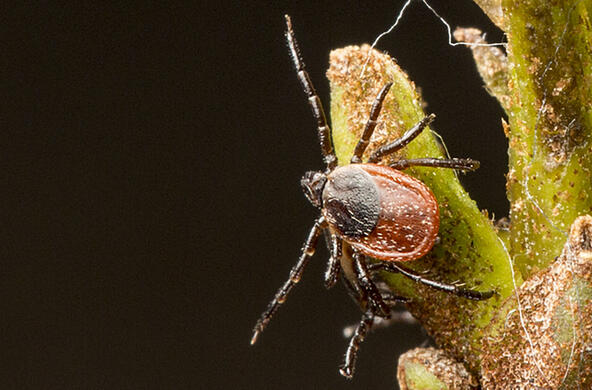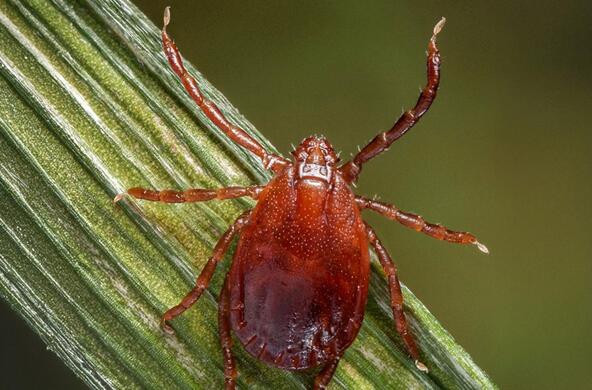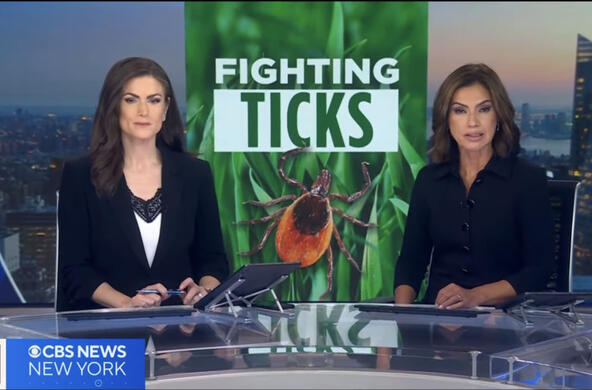May is Lyme Disease Awareness Month.
To find out how to steer clear of Lyme disease during "picnic season" - a time when people are more likely to pick up ticks - the National Science Foundation spoke with NSF-funded disease ecologist Rick Ostfeld of the Cary Institute of Ecosystem Studies in Millbrook, N.Y., and program director Sam Scheiner of NSF's Division of Environmental Biology.
Ostfeld's research is funded by the joint NSF-NIH Ecology and Evolution of Infectious Diseases Program and NSF's Long-Term Research in Environmental Biology Program.
1) What have we learned about how Lyme disease is transmitted?
Lyme disease can develop when someone is bitten by a blacklegged tick infected with a virulent strain of the bacterium Borrelia burgdorferi. At least 15 strains of the bacterium are found in ticks, but only a few turn up in Lyme disease patients, says Ostfeld.
Newly hatched larval ticks are born without the Lyme bacterium. They may acquire it, however, if they feast on a blood meal from an infected host. Scientists have learned that white-footed mice, eastern chipmunks and short-tailed shrews can transfer the Lyme bacterium to larval ticks.
Tick nymphs infected with Lyme bacteria pose the biggest threat to humans; their numbers are linked with the size of mouse populations.
2) The list of illnesses spread by blacklegged ticks seems to increase each year. What's going on?
People in the Northeast, Mid-Atlantic, and Midwest have experienced waves of "new" tick-borne diseases. It started in the 1980s with Lyme disease. Then in the 1990s it was anaplasmosis, followed in the early 2000s by babesiosis. Now we may be seeing the emergence of Borrelia miyamotoi, says Ostfeld.
The pathogens are transmitted by blacklegged ticks. "We suspect that they were present for decades in isolated geographic areas, but we're working to understand what's triggering their spread," says Ostfeld. For example, while Lyme disease bacteria can be carried long distances by birds, Anaplasma and Babesia don't fare well in birds.
3) How do small mammals play a part?
Mice, chipmunks and shrews play a major role in infecting blacklegged ticks with the pathogens that cause Lyme disease, anaplasmosis, and babesiosis. Ticks feeding on these animals can acquire two or even all three pathogens from a single bloodmeal, says Ostfeld.
Health care providers need to be aware, he says, "that patients with Lyme disease may be co-infected with anaplasmosis and babesiosis, which will affect symptoms, treatments, and possibly outcomes. The good news is that by regulating these small mammals, we can reduce our risk of exposure to all three illnesses."
4) How are predators like foxes protecting us against diseases such as Lyme?
Some predators appear to be protecting our health by regulating small mammals, Ostfeld says. Research suggests that where red foxes are abundant, there is a lower incidence of Lyme disease in the human population.
"We're investigating whether foxes and other predators reduce our risk by preying on the small mammals responsible for transmitting Lyme disease to ticks," says Ostfeld. "We don't yet know whether predators like owls and hawks behave similarly."
5) How is climate change influencing the spread of tick-borne illnesses?
The northward and westward spread of blacklegged ticks and Lyme disease in recent decades is caused in part by climate warming, says Ostfeld. However, Lyme disease has also been spreading south, which is unlikely to be caused by climate change, scientists believe.
Models predict that Lyme disease will continue to move to higher latitudes and elevations over coming decades, a result of milder winters and longer growing seasons. "We're currently exploring how climate warming affects the seasonal timing of host-seeking and biting behavior of ticks," says Ostfeld.
6) Why are we more likely to contract Lyme disease in fragmented forests?
"When humans fragment forests, often through urbanization, we create conditions that favor the small mammals that amplify Lyme disease," Ostfeld says.
The species consistently found in forest sites, no matter how small or isolated, is the white-footed mouse. And lyme-infected ticks are often most abundant in the smallest forest patches, leading to a high risk of human exposure.
"To combat Lyme disease, one of the fastest growing threats to human health in the U.S., we need to know where it is, how it's transmitted, and how it can be controlled," says Scheiner.
"Long-term studies, such as work by Ostfeld and colleagues, show that the abundance of the disease-causing bacteria is determined by the number and variety of small mammals in a community. The research also demonstrates the value of conserving biodiversity as a way of limiting the spread of disease."
7) Aren't mice affected by ticks?
Long-term monitoring of mice and ticks in upstate New York shows that mice survive just as well when they're infested with hundreds of ticks as when they have few or no ticks. In fact, male mice survive longer when they have more ticks, Ostfeld says.
"This is bad news, as it means that heavy tick loads won't bring down mouse numbers, which would have helped reduce the human risk of tick-borne diseases."
8) Why are ecological studies essential to understanding emerging infectious diseases?
Tick-borne disease takes a huge toll on public health and on the economy, says Ostfeld. "Take the case of Lyme disease, where diagnosis and treatment remain controversial. One thing that everyone can agree on is the importance of preventing exposure. Doing this requires understanding the ecology of ticks, pathogens and hosts."
The more we know about where and when the risk is high, he says, the better we'll be able to protect ourselves and respond appropriately when we're exposed.
9) What precautions might be wise for people wishing to spend time outside?
"I'd recommend the use of tick repellents on skin or clothes, paying special attention to shoes and socks," Ostfeld says. "Tick nymphs seek hosts on or just above the ground, so shoes and socks are the first line of defense." Some studies show that daily tick checks during late spring and early summer can be protective.
Knowing the early symptoms of Lyme disease - fever, chills, muscle aches, often a large rash - is important. "People who live in the heaviest Lyme disease zones of the Northeast, Mid-Atlantic, and Upper Midwest," says Ostfeld, "and who start feeling flu-like symptoms, especially from May through July, should ask their doctors to consider Lyme disease."
10) Does this mean that we should stay inside so we don't risk becoming infected?
The likelihood of contracting Lyme disease is very low overall, says Scheiner, "and is even lower if you take reasonable precautions. Don't let the threat of Lyme disease keep you from enjoying the best part of spring and summer: the great outdoors."








